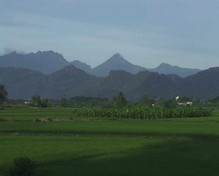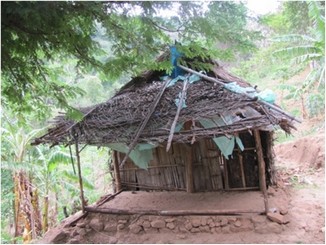Agasthya
A newsletter on the Natural History, Ecology
and Conservation of the Agasthyamalai region, Western Ghats, India.
ASHOKA TRUST FOR RESEARCH IN ECOLOGY AND THE ENVIRONMENT
Centre for Excellence in Conservation Science
Royal Enclave,Srirampura,Jakkur Post
Bangalore-560064
Telephone: 080-23635555 (EPABX)
Fax : 080- 23530070
Any and all opinions expressed in this newsletter are solely those of the author(s) and do not reflect the opinion of ATREE.
Editorial Team
Editor: T. Ganesh
Associate editor: Vivek Ramachandran
Editorial Review: R. Ganesan, M. Soubadra Devy
Design and presentation: Vivek Ramachandran
A S H O K A T R U S T F O R R E S E A R C H I N E C O L O G Y A N D T H E E N V I R O N M E N T
Traditional Kani dwelling at Peria Mailar
Photo: Abhisheka K.
A passion for interior designing and ecology got me doing a course at ATREE. In recent times, terminologies such as eco-friendly interiors, houses and resorts are common among urbanites. I didn't want to follow my seniors footsteps to indulge eco-friendly interiors without having the knowledge of ecology and also not miss the opportunity of a 10 day field course at KMTR. After completing the course, I had exposure to a wide spectrum of topics on conservation.
During these 15 days, I've visited some beautiful places and also met some very interesting and experienced people in the field of ecology. Part of the course, was that each one of us had to do a project, which for me was a surprise and the turning point. I got in depth with the history of construction and the evolution of materials and how standard sizes came into existence in communities in and around KMTR.
Materials used for construction do make a significant difference in the inside temperature of habitation. Grass, wood, terracotta, Mangalore tiles and red oxide keep the inside temperature cooler whereas R.C.C roofs, asbestos tend to absorb heat making it warmer. Communities have adjusted through time with the hot air inside for various reasons, few say the government has banned using grass or wood from the forest which was where most of their material would come from. Some people who do have access, say they are old and cannot go to get grass. There are people who like asbestos because its permanent and needs no change over time unlike the grass or dry coconut leaves which have to be changed after a period of 5 years. Ventilation also plays a major part in keeping the place cooler. Earlier houses had a gap between the roof and the wall so that there is better air circulation. Now the gaps are closed due to privacy requirements and robbery and given way to doors and windows. In Singampatti, the houses have raised walls around it with elaborate partitioning of space in the form of different rooms which is used as a barrier against the high winds and strong sunlight experienced in this region.
This exercise made me realize how shear aesthetics cannot dominate the choice of material for construction. There were many learnings I am carrying back from the community for my ineterior design.








